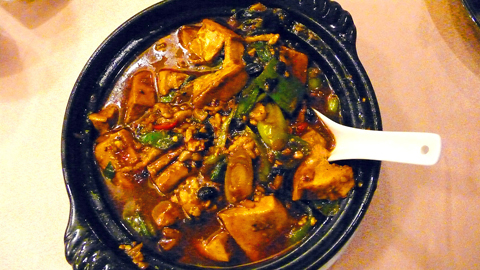Just about everyone who has been to a Chinese restaurant in North America has heard of General Tso’s chicken. But few people know the inventor of the sweet-and-sour deep-fried Hunan dish is Peng Chang-kuei (彭長貴), who opened Peng Yuan in Taipei in 1980 after running a successful restaurant business frequented by celebrities like Henry Kissinger in New York City during the 1970s.
According to the restaurant’s Web site, Peng was a favorite pupil of famed early 20th-century Chinese chef Cao Jing-chen (曹藎臣). After fleeing with Chiang Kai-shek’s (蔣介石) forces to Taiwan, Peng took up the role as the chef for national banquets. It was during this period when the legendary culinary artist started inventing recipes by modifying traditional Hunan dishes, including that of General Tso’s chicken.
It is said that many of the Hunan dishes served at restaurants in Taiwan are adaptations of Peng’s recipes.

PHOTO: HO YI, TAIPEI TIMES
Now a restaurant empire with seven locations in Taiwan that is run by Peng’s eldest son, Peng Yuan is where gourmands go to revisit the master’s oeuvre. This reviewer visited the flagship store on Linsen North Road, which has a second floor that can be used for wedding banquets and a third floor that is partitioned into rooms which seat around six tables of diners.
Renamed chicken a la viceroy (左宗棠雞, NT$280), Peng’s General Tso’s chicken is by no means the sweet variation usually found at Chinese restaurants in the US. Seasoned with chili and soy sauce, the dish doesn’t go overboard in spicing up the boneless chicken drumstick meat, which is tender on the inside and crispy on the outside.
Peng is also credited with inventing what has now become another culinary classic — fu kuei shuang fang (富貴雙方, NT$90 per tiny slice). Think of the dish as a Chinese sandwich filled with roasted bean curd slices (烤素方) and Chinese honey-glazed ham. The ham has just the right amount of fat to give the dish a juicy taste without seeming greasy, while the roasted bean curd is crunchy. Each bite is an explosion of tastes and textures.
Unlike fu kuei shuang fang, which was concocted for national banquets, Peng’s bean curd (彭家豆腐, NT$240) is a meal that the master created for his own lunch. Stewed with fermented soybeans, garlic and pork, the simple dish eloquently exemplifies the typical Hunan taste that is salty and spicy.
Other Hunan specialties include minced shrimp with lettuce (生菜蝦鬆, NT$480), shredded lamb tripe with yellow leeks (韭黃羊肚絲, NT$360) and the steamed assorted preserved meats (蒸腊味合, NT$480), a generous plate of preserved pork, fish and duck.
— HO YI

This is the year that the demographic crisis will begin to impact people’s lives. This will create pressures on treatment and hiring of foreigners. Regardless of whatever technological breakthroughs happen, the real value will come from digesting and productively applying existing technologies in new and creative ways. INTRODUCING BASIC SERVICES BREAKDOWNS At some point soon, we will begin to witness a breakdown in basic services. Initially, it will be limited and sporadic, but the frequency and newsworthiness of the incidents will only continue to accelerate dramatically in the coming years. Here in central Taiwan, many basic services are severely understaffed, and

Jan. 5 to Jan. 11 Of the more than 3,000km of sugar railway that once criss-crossed central and southern Taiwan, just 16.1km remain in operation today. By the time Dafydd Fell began photographing the network in earnest in 1994, it was already well past its heyday. The system had been significantly cut back, leaving behind abandoned stations, rusting rolling stock and crumbling facilities. This reduction continued during the five years of his documentation, adding urgency to his task. As passenger services had already ceased by then, Fell had to wait for the sugarcane harvest season each year, which typically ran from

It is a soulful folk song, filled with feeling and history: A love-stricken young man tells God about his hopes and dreams of happiness. Generations of Uighurs, the Turkic ethnic minority in China’s Xinjiang region, have played it at parties and weddings. But today, if they download it, play it or share it online, they risk ending up in prison. Besh pede, a popular Uighur folk ballad, is among dozens of Uighur-language songs that have been deemed “problematic” by Xinjiang authorities, according to a recording of a meeting held by police and other local officials in the historic city of Kashgar in

It’s a good thing that 2025 is over. Yes, I fully expect we will look back on the year with nostalgia, once we have experienced this year and 2027. Traditionally at New Years much discourse is devoted to discussing what happened the previous year. Let’s have a look at what didn’t happen. Many bad things did not happen. The People’s Republic of China (PRC) did not attack Taiwan. We didn’t have a massive, destructive earthquake or drought. We didn’t have a major human pandemic. No widespread unemployment or other destructive social events. Nothing serious was done about Taiwan’s swelling birth rate catastrophe.